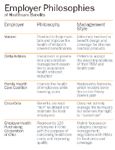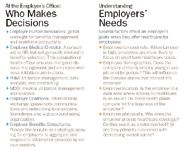Sales and Marketing: Where the Buck Stops
Pharmaceutical Executive
Cost-shifting is still one of the favorite tools in almost all employers' cost-cutting toolboxes. But many fear that shifting too many costs to workers will backfire. Low co-pays keep people healthy and on the job: a big return on investment.
Gone are the days when pharma had two customers. In addition to doctors and patients, pharmaceutical companies ply their wares to increasingly powerful third-party payers and—although they still have a lot to learn about them—to the employers who buy health coverage and pharmaceutical benefits from those insurance companies. As healthcare costs rise at a pace that exceeds revenue growth for most companies, benefits are going from a "must have" to a "nice to have" for many employers. Companies who want to hold onto benefits are becoming more sophisticated customers. Overall, healthcare benefits have come under cost-cutters' scrutiny as employers attempt to control the percentage of revenue dedicated to employee benefits. And because their premiums pay for it, companies want to influence healthcare—from policy and delivery to, in some cases, formulary decisions.

"Business will take a leading role in systematizing healthcare, reducing waste and inefficiencies in the healthcare system in the way that mirrors what they have done in their own companies and industries," said Lee Scott, CEO of Wal-Mart, in a recent interview with The Wall Street Journal.
Scott's vision is proving to be a challenge for many employers. Facing double-digit premium hikes, they struggle to provide high-quality medical coverage at an affordable price. Typically, employers have used cost-shifting as a management tool to decrease their costs. Employers increasingly believe that cost-shifting has been overused and is affecting clinical outcomes. This has caused some employers—Pitney Bowes is one—to develop innovative programs that actually increase pharmaceutical costs, but anticipate a return on investment in the form of better overall healthcare outcomes. Instead of shifting costs to the employee, Pitney Bowes does the opposite. Its program waives out-of-pocket expenses for chronic medications, such as those used for diabetes. Rather than managing short-term costs, the company focuses on increased productivity through better health outcomes
Other employers are simply slashing coverage. But whatever the strategy, employers see few alternatives to becoming more active in benefit design and healthcare management. They want more control over the programs that cover their employees and other beneficiaries. Although employers typically do not make therapy-specific decisions, their decisions directly affect the way pharmaceuticals are covered and costs are shared.
Pharmaceutical manufacturers need to recognize these new sentiments among employers, and use their expertise to help companies design benefit packages at a price that keeps their businesses competitive while ensuring that employees continue to receive high-quality medical care. For employers, this often means maintaining good enough health benefits to attract and retain high-quality workers. In many cases, when pharmaceutical sales reps call on employers, they fail to recognize the differences between these new customers and other, more familiar institutions like hospitals and insurers. To maximize the benefit of contacts with employers, manufacturers must understand employer attitudes toward healthcare as well as the ways they can shape coverage.
In December 2005 and June 2006, The Zitter Group, a pharmaceutical marketing consultancy, hosted the Employer Resource Network (ERN). The ERN is a semiannual meeting, designed as a forum for employer representatives to discuss with peers and pharmaceutical manufacturers a range of social and economic health issues facing employers. These issues affect the pharmaceutical coverage offered to employees. Ultimately, they shape relationships between pharmaceutical manufacturers and employers. The June ERN included 18 senior employer-segment representatives (medical directors, human resources managers, coalition executives, employer benefit consultants and pharmacy benefit managers). These employers provide coverage for over 23 million lives in the United States. (See for the list of ERN participants.)

Employer Philosophies of Healthcare Benefits
The interaction between employers and pharmaceutical manufacturers was a hot topic at both meetings. Representatives agreed that pharmaceutical manufacturers must improve their understanding of how employers function in the benefits arena. As employers become increasingly involved in coverage decisions, there will be significant opportunities for pharmaceutical manufacturers to work directly with employers to design drug coverage. However, employers will expect pharmaceutical manufacturers to focus on their needs, which differ from those of familiar pharma customers like managed care and providers.
Employer Healthcare Objectives
Employers expect pharma representatives to approach them with an "employer frame of mind." Most employers share similar objectives when they offer healthcare benefits to employees. These include:
- Providing competitive compensation and benefits packages in order to recruit high-quality talent
- Providing competitive compensation and benefits packages in order to retain high-quality talent
- Keeping the workforce healthy, which contributes to increased productivity of employees by minimizing absenteeism
- Maintaining coverage for large, retired workforces, which in some cases is as large, if not larger than, the active population of worker families
- Ensuring that healthcare coverage costs do not negatively affect the businesses' ability to maintain market share and profitability.
Unlike hospitals, managed care organizations (MCOs) or insurance companies, employers rarely make all benefit-design decisions without outside support and advice. They do not have the expertise to make all decisions in this arena. Instead, they tend to consult with many diverse parties when making coverage decisions. Therefore, healthcare benefit and coverage decisions are often a complex result of a fragmented healthcare process. Larger employers assume most, if not all, of the risk for benefits. But at the same time, they delegate the granular decision-making to benefits managers, such as managed care organizations and pharmacy benefit managers (PBMs). Consultants are frequently hired to weave the components into a holistic healthcare tapestry. Coalitions do not serve individual employers but work with multiple employers on a regional level to support a variety of initiatives, including wellness, purchasing, and lobbying.

At the Employerôs Office: Understanding
Activists and Passivists
Employers fall into two groups when it comes to designing and managing benefits: activists and passivists. Activists, typically larger employers, take a more significant role in benefits design and decision-making. They are typically self-funded, have performance criteria in their ASO (administrative services only) contracts, and meet frequently with benefits administrators. Passivists, on the other hand, are typically smaller employers that generally accept the recommendations of various healthcare advisors. Employer benefits consultants are increasingly pushing their clients to become more informed and active in their benefits management.
Regardless of employer size, few take a proactive approach to pharmaceutical product decision-making. Instead, many employers have taken a reactive approach. PBMs provide employers with annual and even semi-annual recommendations regarding formularies, coverage, and benefits design. Employers tend to accept most of these recommendations but they sometimes exercise veto rights on elements of these components.
Large employers analyze pharmacy and medical spend on a regular basis. They make changes in benefits after they see usage become more extensive or costly. Cost becomes more of an issue when the employer sees alternative therapies, such as generics or OTC drugs, as options. Some large employers have responded to overuse, for example, by adding an additional formulary tier for lifestyle drugs, proton-pump inhibitors, and non-sedating antihistamines.
The Interaction of the PBM and the Employer
Large employers engage PBMs as ASOs. The employers receive the rebates and discounts directly but they are processed through the PBM. However, employers struggle to quantify the true costs in terms of actual drug expenditures, particularly within the setting of rebates and discounts, which are most familiar to pharma. Employers warn against focusing solely on cost and not on outcomes. This highlights a need for more transparent contracts with PBMs, contracts that must include performance standards.
The Employer View on Benefit Trends
As the ultimate payers of healthcare coverage, employers drive benefit trends. Discussions with employers should focus on challenges from the employer's perspective. Pharma needs to present specific, actionable solutions to employer problems. If an employer has a significant diabetes population, he wants to control the cost of diabetes in his medical plan. One way might be to use a particular drug. However, not all employees will necessarily be candidates for that specific drug. So instead of presenting an educational program on its own drug therapy, a company would do better to work with the employer to develop a diabetes-specific initiative.
Cost-shifting continues to be one of the major tools for employers, although many believe it has been overused. In the majority of cases, employers decide on cost-sharing by drug category rather than individual drug. Other well known strategies include developing performance tiers in formularies, where therapies with proven outcomes get more favorable positions, if pharma supplies good outcomes data and contracts aggressively.
Utilization management is also becoming increasingly important as a cost-control tool for employers. By using retrospective utilization analysis to inform future benefit-design modifications, employers try to cut significant cost drivers with limited employer upside in terms of employee productivity or wellness.
Employers favor generics. Through their PBMs and MCOs, many employers are closing formularies and thus limiting therapies to a few select drugs with good outcomes data. More aggressive disease- and utilization-management programs are becoming commonplace as part of the PBMs' and MCOs' benefit offering.
Employers are beginning to institute consumer-directed health plans (CDHPs), but penetration is still minimal. Most representatives at the ERN meeting feel that within the next four years, CDHPs will have a significant impact on pharmaceutical benefits. One consultant at the meeting stated that CDHPs might only be appropriate for financially strapped organizations, in order to significantly decrease near-term healthcare costs. Others are not convinced that CDHPs will decrease healthcare costs. They feel that CDHPs will contribute to employees selecting low-cost options with limited catastrophic benefits, which can undermine primary and preventive care.
The Visit from Pharma: An Employer Perspective
Pharmaceutical representatives call on most large employers. Generally they see either the medical director or the head of human resources. Unfortunately, the value of these visits cannot be quantified. Pharma often brings specific product information, which is informative (and sometimes appreciated). But such information is typically more interesting for providers, insurers, or hospitals. For the employer, product information is generally not actionable. Employers see more value in partnership opportunities with pharmaceutical manufacturers, for disease management and member education.
The most immediate opportunities are with large employers, especially those that are self-funded and have the capacity, resources, and knowledge to become intimately involved in the coverage decisions for pharmaceutical products. In the US healthcare market, all parties are wrestling with complex questions of access, coverage, and quality, so pharmaceutical manufacturers must position themselves as part of the solution. Customizing strategic partnerships to meet the needs of the employer will not only help this new pharma customer, it will provide the pharmaceutical manufacturer a return on investment that can be measured both in sales and good will. By supporting employer initiatives and better understanding employer needs, pharmaceutical manufacturers can only improve the market position of their products.
What Pharma Needs to Learn About Employers
ERN participants identified several areas where pharmaceutical manufacturers came up short in discussions with employers.
+ Lack of credible outcomes data. When outcomes data are provided, they are not tailored to the needs of employers. In the absence of good outcomes data, employers tend to manage costs only. Employers need to see data in "real-world" practice that illuminates the therapy's impact upon health outcomes. They need to see health cost-offsets presented in terms of quality of life (QOL), disability costs, and absenteeism reduction. A key concern for employers is adherence to a needed therapy, so outcomes data should support this notion. Outcomes data should address common co-morbidities and concurrent therapies that may affect adherence.
+ Manufacturers do not understand the needs of employers. Discussions with employers should focus on challenges from the employer's perspective, and should present specific, actionable, and realistic solutions. For example, an employer with a significant diabetes population wants to control the cost of diabetes in its medical plan. This can be accomplished through a variety of means, one of which can be using the manufacturer's drug. However, not all employees will necessarily be candidates for the drug. Working with this employer on a diabetes-specific initiative is more helpful than developing an educational program for the drug therapy.
+ Meetings lack concrete objectives and clear messaging. While companies frequently call on employers, meetings often miss employer expectations by having no clear agenda. Employer executives block out their schedules to accommodate these meetings, but then discover there was no clear reason for the meeting. Several ERN participants said they receive conflicting or inconsistent messages from representatives of the same manufacturer when it comes to program support: "One representative assured me they'd support this program and then a different representative told me that was not possible," an ERN participant complained. "So, which is it?"
Despite these issues, employers see opportunities to build better relationships with pharma.
+ Educate employer staff. Supporting the employers' efforts to educate their staff regarding medical issues is the biggest opportunity for manufacturers when they seek to establish a relationship and serve unmet needs. Most staff people who make benefits decisions do not have medical backgrounds. They usually are human resource (HR) generalists who need help to understand the value of the purchase. A pharmaceutical manufacturer's expertise can help, if offered in an unbiased manner.
+ Provide more unbranded programs with easy access. Employers are confident that a pharma focus on a specific disease will benefit the pharmaceutical manufacturer while winning employer trust. Welcome contributions include material in electronic formats (Web sites, webcasts, CD-ROMs) or concise, ready-to-print articles that can be incorporated into a company's newsletter.
+ Consider cross-brand initiatives. To increase trust, manufacturers could work on initiatives that cross multiple brands and multiple manufacturers. This way, employers will feel less pressured by specific brand initiatives. Focusing on the disease state in general will still positively affect drug sales while not damaging relationships with employers. Examples of these initiatives include funding speakers or providing educational materials distributed to employees on specific diseases. If specific products are mentioned, all treatment options should be discussed.
+ Support national not-for-profits. Manufacturers could partner with national non-profit associations as well as non-profit business and health coalitions to focus on advocacy or treatment for a particular disease state. For example, several pharmaceutical companies partner with the American Diabetes Association to raise funds for diabetes research and awareness.
+ Work with employers on their data in your disease state. In reporting outcomes data, pharmaceutical manufacturers should focus on real-world data that reflect the employer's demographics instead of FDA approval data. Instead of trying to get data from employers, manufacturers should try to help employers use their own data effectively. One example of this would be a model in which employers could populate their own data to get results right away. Alternatively, manufacturers could provide employers with real-life scenarios and case studies so that employers can benchmark initiatives.
+ Work with employer coalitions. Pharmaceutical manufacturers can work through coalitions to ease into partnerships with employers. Many employers are unable to work directly with pharmaceutical manufacturers. Supporting coalitions will amortize the relationships over many employers.
At The Zitter Group, Melinda C. Haren is director of business content, Andy Pecora is vice president of operations, Eryn Feinsod is manager of leveraged tactics, and Mark Zitter is CEO. They can be reached at contact@zitter.com

The Misinformation Maze: Navigating Public Health in the Digital Age
March 11th 2025Jennifer Butler, chief commercial officer of Pleio, discusses misinformation's threat to public health, where patients are turning for trustworthy health information, the industry's pivot to peer-to-patient strategies to educate patients, and more.
Navigating Distrust: Pharma in the Age of Social Media
February 18th 2025Ian Baer, Founder and CEO of Sooth, discusses how the growing distrust in social media will impact industry marketing strategies and the relationships between pharmaceutical companies and the patients they aim to serve. He also explains dark social, how to combat misinformation, closing the trust gap, and more.